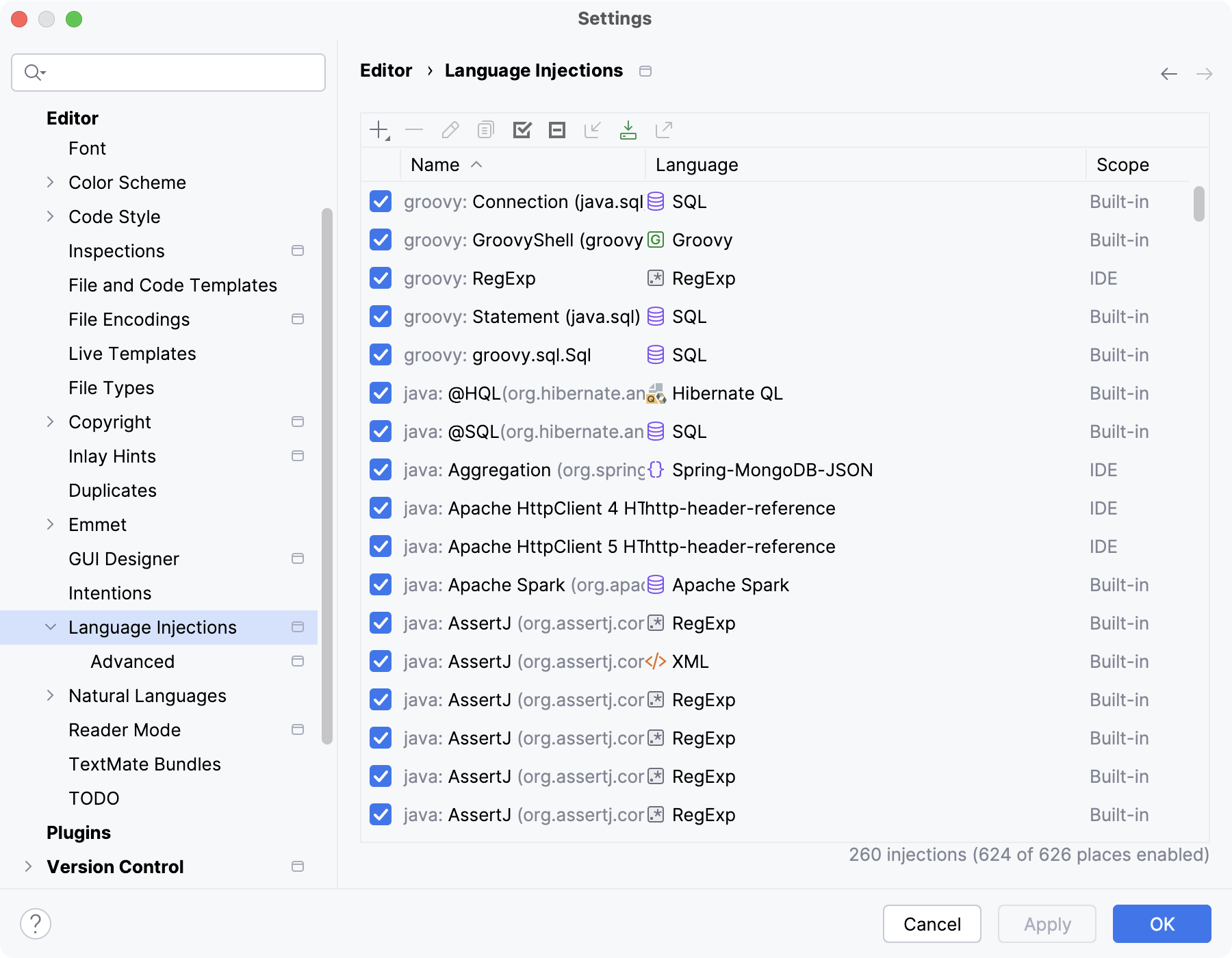Language injections
Last modified: 28 June 2024Language injections let you work with pieces of code in other languages embedded in your code. When you inject a language (such as HTML, CSS, XML, RegExp, and so on) into a string literal, you get comprehensive coding assistance for the injected code even though it is not the main language of your project.
warning
Make sure that the IntelliLang plugin is enabled before you start working with language injections.
Temporarily inject a language
By default, the IDE injects a language temporarily. It means that if you delete the embedded element, the injection will be lost as well.
Place the caret inside the string literal, tag, or attribute, in which you want to inject a language and press (or use the intention action icon
).
Select Inject language or reference and choose the language you want to inject.
Inject a language using the @Language annotation
By using annotations, you can make sure that language injection remains in code until you remove the annotation.
Place the caret inside the string literal, tag, or attribute, in which you want to inject a language and press (or use the intention action icon
).
Select Inject language or reference and choose the language you want to inject.
Press again when you see the popup prompting you to replace the injection with an annotation.
The IDE inserts the
@Languageannotation with the corresponding language ID.Alternatively, on a blank line before the target string literal, type
@Language("language_ID").
tip
Make sure that JetBrains annotations are on the list of dependencies in your project. Otherwise, the IDE will suggest replacing temporary injections with language injection comments instead of annotations.
Use language injection comments
Add a blank line before the target string literal, and type the following comment:
// language=<language_ID>
For comments, use the syntax of the language you want to inject. Language IDs are generally intuitive, for example, SQL, RegExp, XML, HTML.
You can also learn language IDs in settings. Press to open settings and then select Editor | language Injections. Double-click an injection rule for a language; the language ID is specified in the ID field.
Open an injection editor
Place the caret within the injected code piece and press (or use the intention action icon
).
Select Edit <language ID> Fragment.
IntelliJ IDEA will open a dedicated editor section for editing the code with the injected language. This editor provides full coding assistance, including code completion, inspections, intentions and code style actions.

Cancel injections
Place the caret at the code fragment and press (or use the intention action icon
).
Select Uninject language or reference.
To cancel a language injection, you can also delete the injection comment or annotation.
Disable the intention action bulb icon
Do the following to hide the intention action icon in the editor:
Press to open settings and then select Editor | General | Appearance.
Clear the Show intention bulb checkbox.
Apply the changes and close the dialog.
Configure rules for automatic injections
In IntelliJ IDEA, there is a set of predefined rules according to which the IDE automatically injects languages in certain places in your code.
You can configure language injection rules on the Editor | Language Injections page of settings .

All pre-defined injection rules are configured for the Built-in scope. In other words, they are global (and therefore available in all IntelliJ IDEA projects). Custom rules can be configured for the IDE or for one project only. To change the scope of custom injections, use the .
To share a custom rule through VCS, move it to the Project scope using the corresponding option on the toolbar. By doing so, you will create a new file in the .idea directory named IntelliLang.xml with your custom rules that you can place under version control.
If you don’t use a VCS, you can share your rules by exporting them to XML files (click on the toolbar) and then importing them to another project.
To configure custom injection rules, click to add a new rule, or copy a predefined rule and change its settings.
For more information about controls, refer to Language injections.
You can configure the settings so that each time you use a certain method, the IDE will inject the selected language, for example, SQL.
In the Settings dialog , go to Editor | Language Injections.
Click
and select Java Parameter.
From the ID list, select SQL.
In the Class Methods field, enter the method that you want to take an SQL parameter. You can type the method manually, or click
and select the method in the Select Class dialog.
If the method takes multiple parameters, they will be displayed in the dialog. Select the ones that you want to use.
Apply the changes and close the dialog.